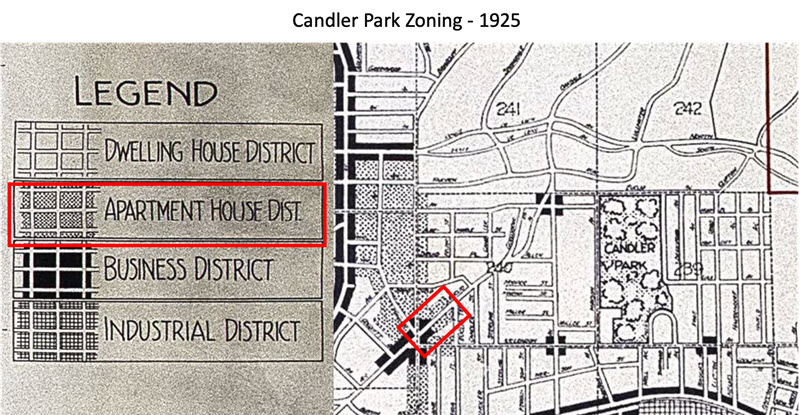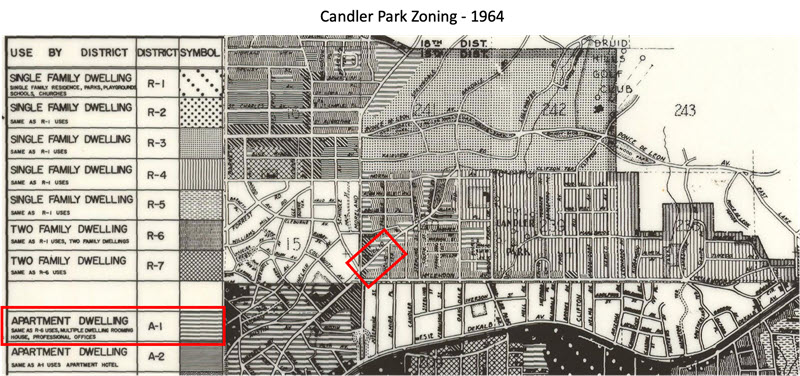By Aaron Fowler
In January, a Euclid Avenue property owner came before the Candler Park Neighborhood Organization requesting support to rezone the property.
This multi-family building at 1221 Euclid is more than 50 years old, but is zoned as single-family. Adding to the intrigue: Eight of the 12 residential buildings on this Euclid Avenue block are multi-family residential homes, but zoned single-family. I originally moved to Atlanta in 2003 to study public policy and city planning at Georgia Tech, and spent the initial part of my career working at the Atlanta Regional Commission and several universities managing campus transportation. For the urban planner in me, my interest was peaked by this seemingly mundane request. How could there be so many multi-family buildings zoned single-family in Candler Park?
For anyone interested in historical maps and Atlanta history, Georgia State University and the Atlanta History Center both have excellent online archives. Those archives are where I started my sleuthing for zoning history. What I found is worth us better understanding as a neighborhood.

One of the first Atlanta zoning maps I came across dates back to 1925. Interestingly enough the concept of Euclidean zoning, where planners designate a single purpose to a piece of land, was a recent phenomenon in the United States. As the popularity of Euclidean zoning spread, Atlanta and many cities across the country began using it as a mechanism to segregate communities.
Atlanta’s segregated zoning, where it designated race-based residential districts, made it to the Georgia Supreme Court in 1924. The book The Color of Law by Richard Rothstein is a great resource to learn more about Atlanta’s zoning practices during this time. The case was focused on the constitutionality of Atlanta’s relatively new zoning map from 1922. The City’s zoning consisted of “R1 white districts”, “R2 colored districts” and undetermined districts. When the State Supreme Court invalidated Atlanta’s race-based zoning districts, the city relabeled its white residential districts as “Dwelling Houses” and its black residential districts as “Apartment Houses.”
Because the city couldn’t explicitly zone based on race, it sought to get a similar result through economic means. In this zoning map from 1925, you can see that the property in question, and the entire block, were zoned as Apartment House.

Moving forward in Atlanta’s zoning history, maps from 1964 and 1970 tell a similar land use history for that block. The Euclid property at 1221 was still zoned as multi-family. Interestingly, between the 1970s and today’s zoning map all of the properties shown as having historical multi-family zoning on Euclid Avenue were downzoned as single-family. This likely happened during the 1982 zoning update. Downzoning is a fairly rare practice, but is classified as when the new zoning is considered less intensive than the previous. In the 1980s Atlanta’s zoning changes brought sweeping downzoning across the city, and according to the Department of City Planning nearly 60 percent of the city was zoned as single family housing at the time. This same publication by city staff lays out that the rapid rise in housing costs across Atlanta is related to its out of date zoning code from the 1980s. In effect, the downzoning in the 1980s limited Atlanta’s future growth and reduced housing options for low-income residents. With limited changes, this zoning and development code from the 1980s is still what guides our land use policy today.
In regards to the downzoned properties on Euclid, even if a property is no longer matching its zoned use, an owner is still entitled to continue using the structure at the more intensive use so long as its higher use is maintained. While rights for a downzoned property owner can vary by municipality, in Atlanta there are guidelines in place to allow for the restoration and renovation of downzoned properties if damaged or destroyed. The staff report from the February 1 Zoning Review Board meeting related to the Euclid property outlined this section of city code in detail.

Before my hunt for neighborhood zoning history started, I had wrongly assumed that Candler Park had always been a single-family neighborhood. While much of the neighborhood has roots in single-family living, the Euclid property alone has 100 years of history in being zoned multi-family and having a multi-family structure on its property. The same is true for many of our neighborhood’s multi-family structures. What I’ve come to realize is that since our neighborhood became known as Candler Park in the 1920s, we’ve always had a diversity of housing types.
Aaron Fowler, a resident of Iverson St., has lived in Candler Park since 2022.